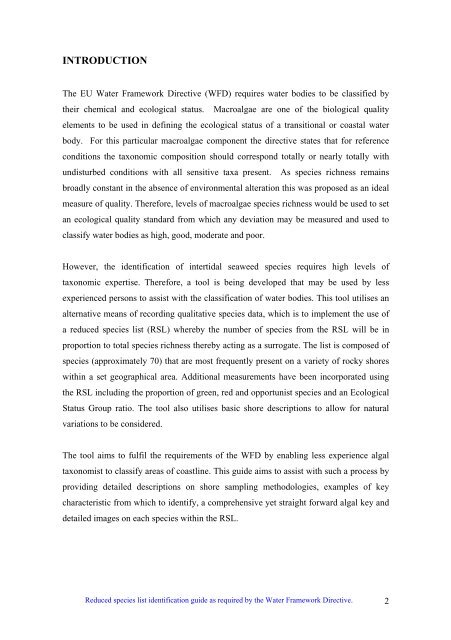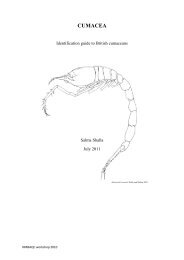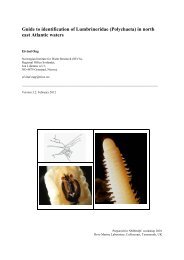s A Field Guide to the British Seaweeds - NMBAQC
s A Field Guide to the British Seaweeds - NMBAQC
s A Field Guide to the British Seaweeds - NMBAQC
You also want an ePaper? Increase the reach of your titles
YUMPU automatically turns print PDFs into web optimized ePapers that Google loves.
INTRODUCTION<br />
The EU Water Framework Directive (WFD) requires water bodies <strong>to</strong> be classified by<br />
<strong>the</strong>ir chemical and ecological status. Macroalgae are one of <strong>the</strong> biological quality<br />
elements <strong>to</strong> be used in defining <strong>the</strong> ecological status of a transitional or coastal water<br />
body. For this particular macroalgae component <strong>the</strong> directive states that for reference<br />
conditions <strong>the</strong> taxonomic composition should correspond <strong>to</strong>tally or nearly <strong>to</strong>tally with<br />
undisturbed conditions with all sensitive taxa present. As species richness remains<br />
broadly constant in <strong>the</strong> absence of environmental alteration this was proposed as an ideal<br />
measure of quality. Therefore, levels of macroalgae species richness would be used <strong>to</strong> set<br />
an ecological quality standard from which any deviation may be measured and used <strong>to</strong><br />
classify water bodies as high, good, moderate and poor.<br />
However, <strong>the</strong> identification of intertidal seaweed species requires high levels of<br />
taxonomic expertise. Therefore, a <strong>to</strong>ol is being developed that may be used by less<br />
experienced persons <strong>to</strong> assist with <strong>the</strong> classification of water bodies. This <strong>to</strong>ol utilises an<br />
alternative means of recording qualitative species data, which is <strong>to</strong> implement <strong>the</strong> use of<br />
a reduced species list (RSL) whereby <strong>the</strong> number of species from <strong>the</strong> RSL will be in<br />
proportion <strong>to</strong> <strong>to</strong>tal species richness <strong>the</strong>reby acting as a surrogate. The list is composed of<br />
species (approximately 70) that are most frequently present on a variety of rocky shores<br />
within a set geographical area. Additional measurements have been incorporated using<br />
<strong>the</strong> RSL including <strong>the</strong> proportion of green, red and opportunist species and an Ecological<br />
Status Group ratio. The <strong>to</strong>ol also utilises basic shore descriptions <strong>to</strong> allow for natural<br />
variations <strong>to</strong> be considered.<br />
The <strong>to</strong>ol aims <strong>to</strong> fulfil <strong>the</strong> requirements of <strong>the</strong> WFD by enabling less experience algal<br />
taxonomist <strong>to</strong> classify areas of coastline. This guide aims <strong>to</strong> assist with such a process by<br />
providing detailed descriptions on shore sampling methodologies, examples of key<br />
characteristic from which <strong>to</strong> identify, a comprehensive yet straight forward algal key and<br />
detailed images on each species within <strong>the</strong> RSL.<br />
Reduced species list identification guide as required by <strong>the</strong> Water Framework Directive.<br />
2




